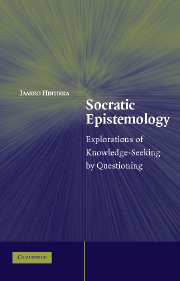Book contents
- Frontmatter
- Contents
- Acknowledgments
- Introduction
- 1 Epistemology without Knowledge and without Belief
- 2 Abduction—Inference, Conjecture, or an Answer to a Question?
- 3 A Second-Generation Epistemic Logic and its General Significance
- 4 Presuppositions and Other Limitations of Inquiry
- 5 The Place of the a priori in Epistemology
- 6 Systems of Visual Identification in Neuroscience: Lessons from Epistemic Logic
- 7 Logical Explanations
- 8 Who Has Kidnapped the Notion of Information?
- 9 A Fallacious Fallacy?
- 10 Omitting Data—Ethical or Strategic Problem?
- Index
- References
3 - A Second-Generation Epistemic Logic and its General Significance
Published online by Cambridge University Press: 05 June 2012
- Frontmatter
- Contents
- Acknowledgments
- Introduction
- 1 Epistemology without Knowledge and without Belief
- 2 Abduction—Inference, Conjecture, or an Answer to a Question?
- 3 A Second-Generation Epistemic Logic and its General Significance
- 4 Presuppositions and Other Limitations of Inquiry
- 5 The Place of the a priori in Epistemology
- 6 Systems of Visual Identification in Neuroscience: Lessons from Epistemic Logic
- 7 Logical Explanations
- 8 Who Has Kidnapped the Notion of Information?
- 9 A Fallacious Fallacy?
- 10 Omitting Data—Ethical or Strategic Problem?
- Index
- References
Summary
The prima facie Conundrum of Epistemic Logic
Epistemic logic was already practiced in the Middle Ages. (See Boh 1993; Knuuttila 1993.) It was thrust to the awareness of contemporary philosophers by von Wright in his An Essay in Modal Logic (1951, see Chapter 4). In this chapter, I will consider epistemic logic primarily in relation to its epistemological applications. Surely any satisfactory epistemic logic ought to be able to prove its mettle as an epistemo-logic, to coin a phrase. From this perspective, the half-century-long career of epistemic logic presents us with something of a paradox. Epistemic logic was created by philosophers for philosophical purposes. It is one of the core areas in what is (misleadingly) known as philosophical logic. Yet its most promising philosophical suggestions were put forward relatively late, and even then they received but lukewarm attention on the part of philosophers. These potential philosophical applications are in my judgment incomparably more interesting and significant than the technicalities of epistemic logic that routinely receive the lion's share of attention in books and papers on epistemic logic. In typical surveys of epistemic logic (see Lenzen 1978 and 1980), little attention is paid to the epistemological perspectives opened by epistemic logic.
There are several partial explanations of this paradoxical state of affairs. Reasoning about knowledge has become an important subject in such branches of computer science as AI and database theory.
- Type
- Chapter
- Information
- Socratic EpistemologyExplorations of Knowledge-Seeking by Questioning, pp. 61 - 82Publisher: Cambridge University PressPrint publication year: 2007



